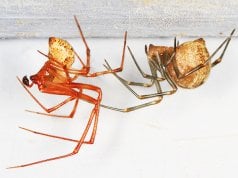
The Elusive Bay Cat: A Deep Dive into the Bornean Mystery
The Bay Cat, also known as the Bornean Bay Cat, is one of the most mysterious and least studied wild cats in the world. Native to the lush rainforests of Borneo, this small feline remains remarkably elusive, a ghost in the green. While often overshadowed by its more famous relatives, the Bay Cat possesses a unique evolutionary history, ecological role, and a delicate existence threatened by habitat loss. This article unravels the secrets of this captivating creature, exploring its biology, behavior, and conservation status.
Basic Facts and Identification
The Bay Cat is a relatively small feline, typically measuring between 48 and 64 centimeters in length, with a tail adding another 15 to 24 centimeters. Adults generally weigh between 2.2 and 5.4 kilograms. What truly sets this cat apart is its coat. As its name suggests, the fur is typically a rich reddish‑brown or bay color, though variations occur. Some individuals display grayish tones, and a distinctive dark stripe often runs along the spine. Unlike many other cats, the Bay Cat’s coat lacks the prominent spotting or striping common in related species. The ears are relatively small and rounded, and the eyes are a striking golden or greenish‑yellow.
Habitat and Distribution
The Bay Cat is endemic to the island of Borneo, shared by Malaysia, Indonesia, and Brunei. It is primarily found in lowland and sub‑montane rainforests, with a preference for undisturbed primary forest. This habitat provides the dense undergrowth and ample prey necessary for survival. Although capable of surviving in secondary forests, the Bay Cat appears to be particularly vulnerable to habitat fragmentation. It prefers areas with abundant vegetation cover for stalking prey and seeking shelter. Recent surveys indicate the cat’s distribution is patchy, with populations concentrated in areas of remaining intact forest, particularly within national parks and protected areas.
Tracking the Elusive Cat: A Guide for Wildlife Enthusiasts
Spotting a Bay Cat in the wild is a significant challenge. These cats are crepuscular and nocturnal, most active during dawn and dusk, and expertly camouflaged within the rainforest. Experienced trackers look for signs such as scat, scratch marks on trees, and footprints. Scat analysis can provide valuable information about the cat’s diet. While direct sightings are rare, camera trapping is proving to be the most effective method for monitoring Bay Cat populations and understanding their distribution. The best locations to try camera trapping include areas near streams, clearings, and game trails within primary rainforest. Patience and a keen eye are essential.
Evolutionary History and Genetics
The Bay Cat’s evolutionary history is complex and relatively poorly understood. Genetic studies suggest that it is closely related to the marbled cat (Pardofelis marmorata) and the Asian golden cat (Catopuma temminckii). However, it exhibits unique genetic characteristics that distinguish it as a distinct species. Some researchers believe the Bay Cat may represent a relict population, a remnant of an ancient feline lineage that once roamed Southeast Asia. Its unique genetic makeup underscores the importance of conserving this species to preserve a valuable piece of evolutionary history.
Diet and Hunting Behavior
The Bay Cat is a skilled predator, primarily feeding on small mammals, birds, reptiles, and amphibians. Rodents, particularly rats and mice, likely form a significant portion of its diet. It also preys on squirrels, lizards, frogs, and occasionally small deer. As an ambush hunter, it relies on stealth and camouflage to approach its prey. It stalks its victims through the undergrowth, using its keen senses to detect movement and sound. Once close enough, it launches a swift attack, using its sharp claws and teeth to subdue its prey.
Mating and Reproduction
Information on the Bay Cat’s mating and reproductive behavior is limited, as observations in the wild are scarce. It is believed that they are solitary animals, except during the breeding season. Gestation is estimated to be around 75 to 80 days. Litter size typically ranges from one to three kittens. Kittens are born in dens constructed within hollow logs, tree cavities, or dense vegetation. The mother provides care for her kittens, feeding them and teaching them hunting skills. Young Bay Cats likely reach sexual maturity around one to two years of age.
Ecological Role and Interactions
As a mid‑level predator, the Bay Cat plays a vital role in maintaining the ecological balance of the Bornean rainforest. By controlling populations of rodents and other small animals, it helps prevent outbreaks and maintains the health of the ecosystem. The Bay Cat shares its habitat with other predators, such as the clouded leopard and the sun bear. Interactions between these species are limited, as they occupy different ecological niches. However, competition for prey resources may occur in certain areas.
Captivity Considerations
Bay Cats are rarely kept in captivity, and no formal breeding programs currently exist for the species. Consequently, conservation efforts focus on protecting wild populations. Any attempt to keep Bay Cats in captivity would require specialized enclosures, a diet of whole prey items, regular veterinary care, and strict biosecurity measures to prevent disease transmission. Because captive breeding is not practiced, preserving the species depends on safeguarding its natural habitat and ensuring the genetic diversity of wild populations remains intact.
Threats and Conservation Status
The Bay Cat is currently listed as Endangered on the IUCN Red List. The primary threat to its survival is habitat loss and degradation due to deforestation, logging, and agricultural expansion. Conversion of forests into palm oil plantations is a particularly significant concern. Hunting and trapping, although less widespread, also pose a threat. The Bay Cat’s low reproductive rate and small population size make it especially vulnerable to these pressures. Conservation efforts include habitat protection, anti‑poaching patrols, and community‑based conservation programs. Strengthening law enforcement and promoting sustainable land‑use practices are also essential.
Encounters in the Wild: What to Do
If you are fortunate enough to encounter a Bay Cat in the wild, it is essential to remain calm and respectful. Maintain a safe distance and avoid making any sudden movements. Do not attempt to approach or disturb the animal. Observe it from afar and allow it to continue its natural behaviors. Report your sighting to local wildlife authorities or conservation organizations. Your observations can contribute valuable data to ongoing research and conservation efforts.
Interesting Facts
- The Bay Cat is also known as the Borneo Bay Cat.
- It is one of the smallest wild cats in Borneo.
- Its coat color can vary from reddish‑brown to grayish.
- The Bay Cat is a skilled climber and swimmer.
- It is a secretive and elusive animal, rarely seen by humans.
- Its scientific name is Catopuma badia.
- The cat’s paws are unusually large in proportion to its body size.
The Bay Cat remains one of the most mysterious and understudied wild cats in the world. Its future depends on our commitment to protecting its fragile habitat and ensuring its long‑term survival. By supporting conservation efforts and promoting sustainable land‑use practices, we can help ensure that this beautiful and elusive creature continues to roam the rainforests of Borneo for generations to come.






![Red Angus Closeup of a beautiful Red Angus cowPhoto by: U.S. Department of Agriculture [pubic domain]https://creativecommons.org/licenses/by/2.0/](https://animals.net/wp-content/uploads/2020/03/Red-Angus-4-100x75.jpg)

